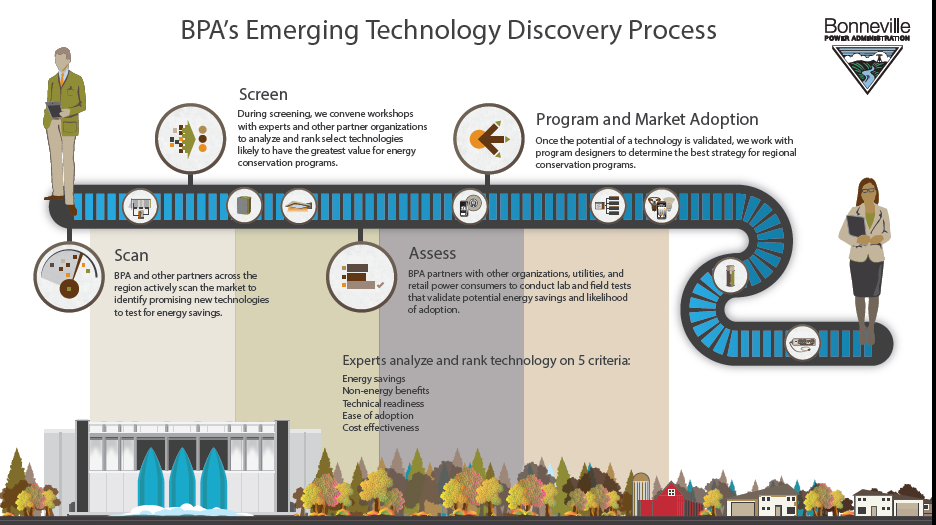The Northwest relies on BPA’s emerging technology research to assess promising new technologies to fill the pipeline for energy conservation programs. BPA’s ET program fills this role, evaluating energy-saving technologies in residential, commercial, industrial, and agricultural applications—from light bulbs and air conditioning units to large pieces of industrial machinery. The program provides information needed by local electric utilities to offer financial incentives to encourage customers to adopt these products. And by continually scanning the market for emerging savings opportunities, BPA’s ET program helps ensure a steady supply of new products that can be adopted for years to come.
To accomplish the goal of accelerating technologies to widespread adoption, ET has established a process that is comprised of four stages:

Stage 1: Scan
During this stage, ET scans the landscape for the most promising new energy saving technologies. ET collaborates with both regional and national organizations to cast a broad net during the search. A diverse panel of experts shares their knowledge of what is currently available and what other R&D activities are underway.
Stage 2: Screen
During this stage, technologies are prioritized based on energy savings estimates, cost, and ease of adoption. Additional screening criteria are also considered at this stage, including whether a technology can help BPA and Northwestern utilities accomplish strategic goals and whether a technology offers other benefits to customers or the electric grid. Those technologies with the greatest promise move on to further assessment.
Stage 3: Assess
During this stage, products are evaluated in the laboratory and in the field to confirm that actual performance lives up to expectations. BPA often partners with its utility customers in field tests as part of these assessments. Field testing can also help us understand non-energy performance criteria, like enhanced comfort and improved user experience, or excessive noise and difficult operation. These non-energy criteria influence the likelihood of a new technology being adopted by consumers.
Stage 4: Design Program
Once energy savings are validated, large-scale promotion of the technology begins in the region. This is the final market adoption phase during which rebates may be offered for high efficiency technologies or be supported by other strategies like contractor education, engineering assistance, and marketing support. As a technology becomes more widely adopted in the market or becomes part of national building codes and standards, the focus shifts to the next new, more efficient technology coming through the pipeline.
In addition to these four Steps, BPA’s ET efforts include additional components that help the overall technology evaluation process function more smoothly


